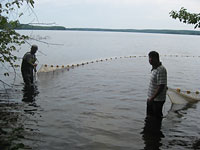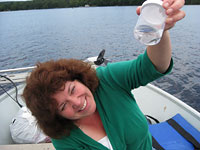

 | |||||||||||||
|
|
Journals 2009/2010Teresa Gable
August 13, 2009 Today, I worked with Bill Locke and Adam Marquis who conduct field research for Dr. Theo Willis, Aquatic Ecologist and adjunct scientist with the University of Southern Maine in the Aquatic Systems Group. Our task was to sample Damariscotta Lake for juvenile alewife fish. The lake is a freshwater lake and it is located north of Wiscasset.
Alewife (Alosa pseudoharengus) live in salt water most of the time and grow to be 10 to 11 inches long. In the spring they run up coastal streams and rivers toward freshwater lakes and streams to spawn. They eat zooplankton and tend to travel along the coast in large schools. Lobstermen use alewives as bait for lobster. Alewives were once abundant along the Maine coast but are now considered a "species of concern" due to overfishing and dam placement in rivers that block adult alewives from traveling upstream to spawning grounds. We used a purse seine to sample the top 10 feet of water from a boat to capture juvenile alewife. They often reside in the top layers of the lake water and they are more difficult to sample in the deeper water. We sampled three sites but focused our attention on the site at the north deep basin of the lake. There, we sampled at 45, 35, 15 and 5 feet of water. We captured one juvenile alewife at 15 feet. I was surprised at how tiny they were. The fish was only about 2.5 cm in length. The previous week, several juvenile alewives were caught and analyzed. The juvenile alewives have begun to migrate to salt water, therefore, as predicted, there were very few left to be captured.
The fish was stored in a container and brought back to the lab to examine the contents of its stomach. The researchers will need to use a microscope to see the zooplankton which serves as the food source for this type of fish.
|
||||||||||||


